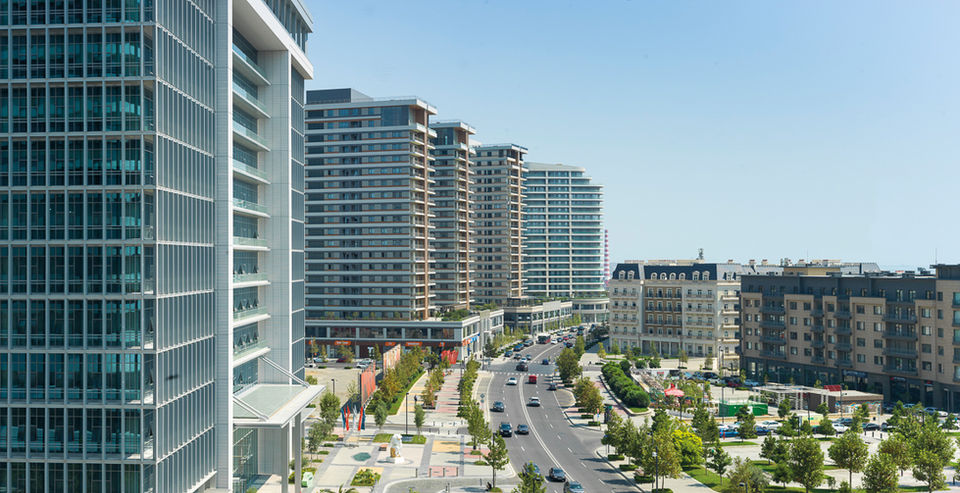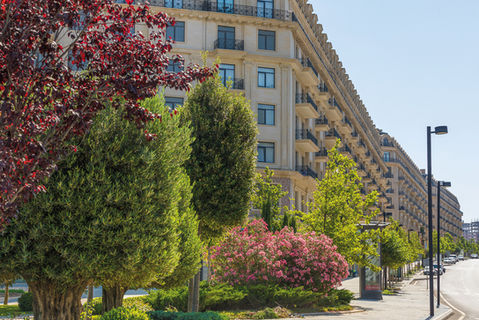

AZERBAIJAN DEVELOPMENT COMPANY (ADEC)
REGENERATE
Baku White City
Azerbaijan Development Company (ADEC), under the “regenerate” theme, exhibits the Baku White City Project – an ambitious urban redevelopment initiative transforming the heavily industrialized and environmentally degraded “Black City,” once the heart of Azerbaijan’s oil industry, into a modern and sustainable district. As part of the project, ADEC is also showcasing the Baku White City Bridge, a symbolic structure representing connection, transformation, and progress, highlighting the district’s transition from an industrial past to a sustainable future through collective effort.

ADEC
Azerbaijan Development Company (ADEC) plays a key role in urban development and infrastructure projects, with a strong focus on sustainability. Notably, it leads the Baku White City Project, one of the Caucasus’s largest developments, featuring 120,000 residential and commercial units, 240,000 workplaces, and cultural spaces. Prioritizing green spaces, it also hosts the COP29 Azerbaijan Operating Company, reinforcing ADEC’s commitment to sustainability.

Forward-looking vision
Baku White City
For more than a century, since the 1870s, the centre of Baku Bay has been a focal point for the refining, storage and transportation of oil. This resource, a gift of nature and also known as “black gold,” spurred a major economic boom for the country, creating countless opportunities for prosperity. As a result of its pivotal role in industrial activities, this area, an integral part of Baku, became known as “Black City”. This continued throughout the 20th century, especially during the period when Azerbaijan was part of the Soviet Union.
Unfortunately, the extensive industrial exploitation also took a heavy toll on the environment, leading to significant ecological degradation. The necessity arose for sustainable redevelopment to restore the balance between industrial progress and environmental preservation.
Collective effort following the decree entitled “The Comprehensive Action Plan on Improving the Environmental Situation in the Republic of Azerbaijan for 2006-2010,” instigated the Baku White City project. The project stands as a living testament to Azerbaijan’s dedication to environmental stewardship and sustainability, exemplifying the country’s growing role on the global stage as a proponent of climate action.
The Baku White City Project is a remarkable transformation, turning an ecological disaster into an area of comfortable residential complexes, high-quality public transport, green spaces, sustainable business centres and innovative architecture, while also serving as a centre for modern art and leisure.

View of factories in the Black City (panorama), 1966.
Photographer: N.G. Ignatyev. From the State Archive of Cinema
and Photographic Documents of the Republic of Azerbaijan
1837
The first oil refinery in Baku was built, one of the first in the Russian Empire. The project was designed by engineer N.I. Voskoboinikov.

1848
In the Baku suburb of Bibi-Heybat, the world's first oil well produced oil using the percussion method with wooden rods.

1863
The world-famous chemist Dmitri Mendeleev came to work as a consultant at the Baku Oil Refinery. He developed projects on continuous oil distillation, oil tanks, storage tanks, and pipelines.

1873
The tsarist authorities permitted the sale of oil fields to private individuals, and the world's largest companies rushed to Baku. Soon, 80 oil refineries were under construction there. To avoid polluting the city's air, the site allocated for the refineries was about 2 km away, on land that had formerly been used as pasture and vegetable fields.

1876
A project was drafted for an industrial area where new oil refineries, warehouses, workshops, retail shops, wharves, and later, housing for oil workers, were built. It was prohibited to build factories outside this area.

1880
By now, there were 118 oil refineries in Baku’s industrial district. Because of the soot and smoke emitted from the factories, the district became known as “Black City”. Eyewitnesses wrote: “Everything is black, the walls, the earth, the air, the sky. You smell the oil, inhale the fumes; the pungent smell suffocates you. You walk within clouds of smoke that block the sky.”

1897
Construction of the Baku-Batumi main pipeline, the world's largest, began. It stretched for 835 km and could transport up to 1 million tons of oil per year. Oil terminals for loading railway tankers were also built in Black City, contributing to further soil contamination.

1905
The first large-scale oil fire in world history occurred in the Baku oil fields. The fire completely destroyed 1.996 oil wells. The black smoke from the fires pushed Baku, home to more than 150.000 people, to the brink of an ecological disaster.

1941
The Baku region gave the Soviet Union 23.5 million tons of oil - 75% of the nation’s total production and the highest level in the history of Azerbaijani oil production. Oil refining in the Black City factories continued with no observation of environmental standards, and this inflicted catastrophic damage on the area.

2011
On 24 December, with participation by the country's leadership and public representatives, a ceremony was held on the site of Black City to lay the foundation stone of a new White City (Baku White City). For the first time in Azerbaijan’s history, factories were moved out of the city, and a comprehensive programme began to improve the environmental situation there.

2016
On December 26, work on the first quarter of White City (Baku White City), known as “Green Island” and featuring French-style residential buildings, was commissioned. The construction of residential and service facilities, as well as parks and squares, was underway.

2024
The 29th UN Climate Change Conference was held very successfully in Baku from November 11 to 22. This was the first UN climate conference organized in the post-Soviet space, and it was no coincidence that the headquarters of the COP29 Organizing Committee was based in a White City office building. This building was the first in Azerbaijan to receive the “green certificate” for compliance with international BREEAM standards for the built environment.







BLACK CITY
– WHITE CITY
Chronology of Events

The “Intelligens” of
Creating for People






